Small Brown Bugs (With Pictures and Names) – Identification Guide
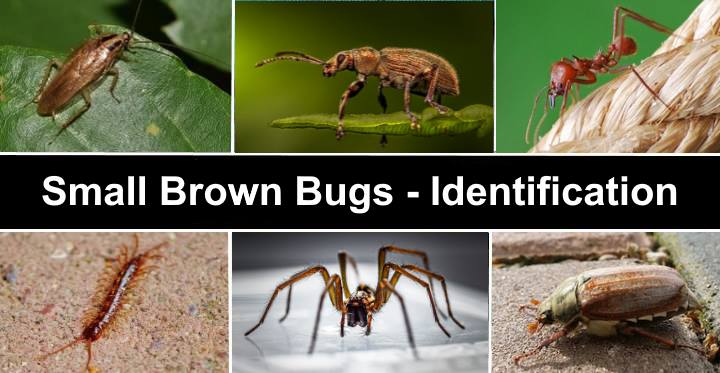
Discovering small brown bugs lurking in your home can send you into a panic. Apart from causing fear, some tiny brown bugs can cause damage, bite you, and spread disease.
For example, brown spiders and minuscule brown bed bugs bite and can leave itchy red bumps on your skin. Brown cockroaches and ticks spread bacterial and viral diseases. Termites can destroy a wooden structure.
Of course, not all tiny brown bugs are a cause for concern. But no one wants to live with a group of crawling, flying, or slithering brown insects and bugs. Getting rid of small brown flies or creeping bugs as soon as you spot them can prevent a more extensive infestation.
Identifying the type of brown bug is the first step to eradicating them. For example, some tiny brown bat bugs look like bed bugs, and some brown beetles have a spider-like appearance. And then, it’s essential to ensure that pets don’t bring disease-carrying fleas or ticks into the home.
True bugs are insects in the order Hemiptera. They include insects such as bed bugs, stink bugs, shield bugs, and aphids. However, not all insects are classified as true bugs. For example, beetles are six-legged insects in the order Coleoptera and roaches are in the order Blattodea. However, brown spiders are not insects but are arthropods in the order Araneae.
Because most people refer to disgusting creeping and flying pests as bugs, this article will refer to all pesky brown insects as bugs.
What should you do if you spot some small brown bugs in your home? This article is a comprehensive guide to identifying common types of tiny brown insects and flies.
How to Identify Small Brown Bugs
You can identify a small brown bug by examining the bug’s shape, size, wings, and the number of legs. You can also identify little brown bugs, by observing heir behavior, habits, and signs of infestation.
To identify tiny brown bugs use a microscope to examine their identifying characteristics.
Tiny Brown Bugs
Tiny brown bugs such as bed bugs, ticks, and fleas may look like little dark dots. But they are usually easier to identify by the small red itchy bumps on your skin that appear after biting. For example, you can see brown ticks if they burrow into the skin for a blood meal and become black and engorged.
Small Brown Bugs
A few clues can help to identify small brown insects that can be pests. Insects have at least two antennae and six legs. Brown beetles tend to have rounded, hard bodies, whereas cockroaches have slender bodies and long antennae. Brown ants are easy to identify due to their thin waist.
Small Brown Bugs in the House (With Pictures) – Identification
Let’s look in more detail at ways to spot common bugs that can infest your home. For some of the bugs, you’ll find simple ways to eradicate them from your rooms, mattresses, furniture, or soft furnishings.
Drugstore Beetle (Stegobium paniceum)
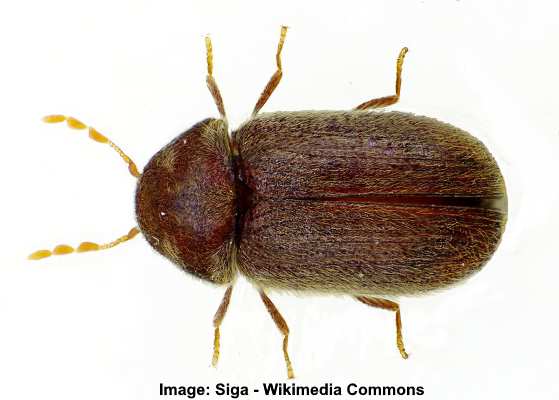
Drugstore beetle is a tiny brown beetle with a hard shell that is commonly found in packets of dried food products
The drugstore beetle is a tiny brown bug with wings and hard shell. The minuscule brown beetle only measures 0.13” (3.5 mm) long and is extremely challenging to spot. It is often found in packets of cereal, flour, bread, and other dried food products.
Looking through a magnifying glass, you’ll notice that the dark brown drugstore beetle has a rounded oval body with rows of fine groves. Their two antennae end in a three-segmented club. Their hard brown shell covers wings, and the adult beetles can fly.
You can usually find tiny brown drugstore beetle larvae in stored food products and near prescription drugs. The harmless adult beetles fly and are often spotted in bathrooms, living rooms, or bedrooms fluttering near light sources.
To prevent the brown beetles from being a nuisance pest, always store dried food items in air-tight containers or in the refrigerator. If you spot a few adult drugstore beetles, locating the larvae and destroying their habitat is vital.
Small Brown Bug Identification: Drugstore beetles (also called biscuit beetles) are tiny brown beetles no more than 0.13” (3.5 mm) long with an oval body, six legs, wings, and two antennae.
American Spider Beetle (Mezium americanum)

The American spider beetle is a little brown beetle that looks like a small spider
The American spider beetle is a tiny reddish-brown bug with a shiny hard shell, light brown colored legs, and a hairy head. The dark brown beetle looks like a spider due to its oval body and spindly legs. Spider beetles measure 0.06” to 0.13” (3.5 mm) long.
Like the drugstore beetle, the spider beetle is a pantry pest. You’ll often find this type of beetle in stored foodstuffs in kitchen pantries. The adult beetles feed on seeds, cacao, cereals, dried fruits, and bread. The dark brown beetle also consumes feathers, silk, wool, and paper.
Small Brown Bug Identification: The American spider beetle has an identifiable globular shiny dark brown body, six hairy tan-colored legs, and a fuzzy brown head and antennae.
Varied Carpet Beetle (Anthrenus verbasci)
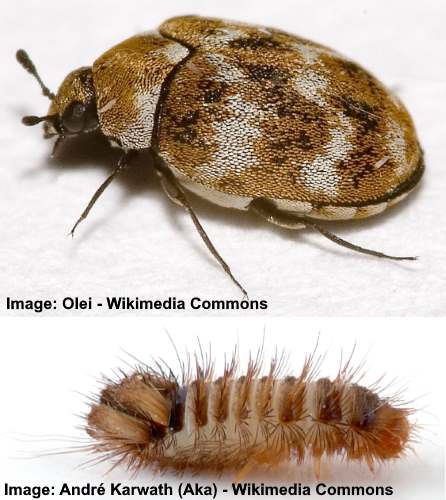
Carpet beetle (top image) and larva (bottom image)
The carpet beetle is a tiny brown flying bug with a hard shell covered in yellow, brown, and white mottled patterns. The flattened, oval beetles measure 0.08” to 0.1” (2 – 3 mm) long. The crawling yellowish-brown bugs typically feed on pollen and nectar.
In the home, carpet beetle larvae can cause a lot of damage. Signs of these hard-shelled brown bugs are when you notice their larvae crawling on carpets or find their shed skins.
Adult carpet beetles lay eggs near a food source, and soon the furry brown larvae start feeding on fibers like cotton, leather, wool, and silk. You can spot the signs of a carpet beetle infestation by the holes appearing in rugs, carpets, and clothing.
Small Brown Bug Identification: The varied carpet beetle has a recognizable brown and yellow body with white patches.
Bed Bugs (Cimex)

The small brown bed bugs have a flat body and can quickly infest the house
Bed bugs are tiny reddish-brown bugs about the size of an apple seed 0.2” to 0.27” (5 – 7 mm) long. The tiny brown oval bugs generally lurk in crevices of bed frames, mattresses, behind headboards, and box springs. You might only spot the signs of bed bug bites by itchy red dots on your neck, arms, face, and hands.
Adult bed bugs are challenging to spot because they are so tiny and only come out at night. Some signs of these “true bugs” include a musty-sweet smell, tiny black fecal spots, or small blood marks on bedsheets. In addition, the blood-sucking brown house bugs tend to congregate in groups, making them easier to find.
A bed bug infestation is tough to control. So, prevention is the best way to prevent the brown bugs from becoming a real nuisance. It’s a good idea to check any used furniture you bring home and be careful of hotel rooms to prevent bed bugs from “hitching” a ride home in your suitcase.
Small Brown Bug Identification: Bed bugs are identified as little brown bugs with a tear-shaped, flat, oval body. Bed bug eggs and nymphs are almost invisible to the naked eye.
Brown Bat Bugs
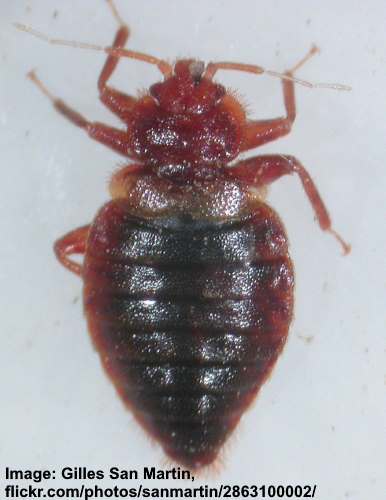
Bat bugs look very similar to bed bugs and they are often mistaken for bed bugs
Brown bat bugs are tiny brown bugs that look like bed bugs. Bat bugs have a similar brown oval body as bed bugs. The disgusting brown insects measure 0.23” (6 mm) long but will be larger and redder after feeding on blood. Bat bugs can live in crevices of beds and dark corners.
The only way to tell brown bat bugs apart from bed bugs is by putting them under the microscope. Although the blood-feeding bugs feed on bat’s blood, they don’t carry disease and are more of a nuisance pest. However, the tiny biting bugs can bite humans, causing itchy red marks on the skin.
Small Brown Bug Identification: Bat bugs are tiny brown bugs with a flattened dark brown oval body in the shape of an apple seed. Signs of a bat bug infestation can be blood stains on bed sheets or furniture.
Weevils (Curculionoidea)
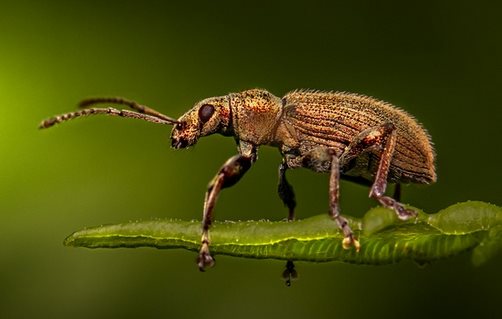
Weevils are small brown or black beetles that can easily infest foodstuffs in your house
Weevils are a type of beetle, and some species are small bugs with brown bodies and long snouts. Brown weevils typically don’t grow longer than 0.23” (6 mm) long. The little brown pests lurk in walls and furniture.
Weevils generally are a nuisance in the home rather than a dangerous brown insect. However, the black or brown elongated bugs can do a lot of damage in your garden as they feed on flowering shrubs and plants.
Small Brown Bug Identification: Weevils have a long black or brown body and have an identifiable long snout.
Ticks (Ixodida)

A close up picture of a tick (left) and a tick on human skin (right)
Ticks are disease-carrying brown bugs with an oval or pear-shaped brown or reddish-brown body. Adult ticks are identified by their four pairs of legs and tiny brown bodies measuring 0.1” (0.3 mm) long. Ticks are blood feeders and cut into the surface of the skin to feed.
The CDC reports that ticks are disease transmitters. Therefore, it’s crucial to identify ticks on your body or pet’s body after being outdoors. Ticks on humans, dogs, or cats may appear as a small black bump on the skin. However, it is also crucial to remove the tick properly to prevent its head from remaining in the skin.
Small Brown Bug Identification: Ticks are small brown oval bugs with eight legs.
Centipedes (Chilopoda)
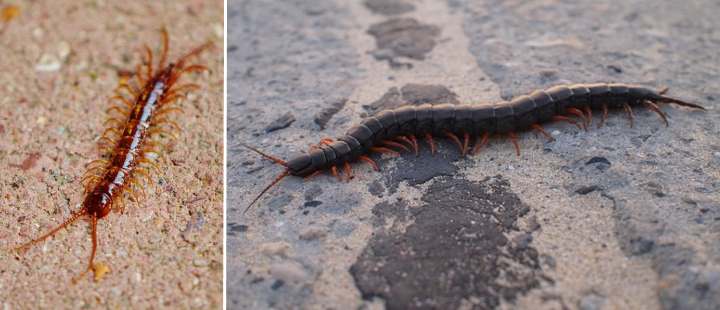
Centipedes are long creepy house bugs that are identified by numerous pairs of legs
Brown centipedes are creepy house bugs that are easy to recognize due to their long slender brown bodies and numerous pairs of legs along their sides. In addition, these creepy brown bugs have a couple of antennae and two tails. Unfortunately, centipedes are also venomous, and some of these long brown bugs can inflict a nasty bite.
Species of centipedes are usually a shade of dark brown or reddish-brown. The creeping brown bugs are generally found in damp, dark places where there are high moisture and humidity levels. In most homes, centipedes are more of a nuisance pest than a harmful brown bug.
Killing centipedes is the best way to get rid of them. Also, fixing leaking pipes and reducing dampness will help prevent the multi-legged bugs from becoming a problem.
Small Brown Bug Identification: Centipedes have an identifiable long, flattened, segmented brown body with a pair of legs on each segment. Centipedes can grow between a few millimeters up to 12” (30 cm) in size.
Fleas (Siphonaptera)
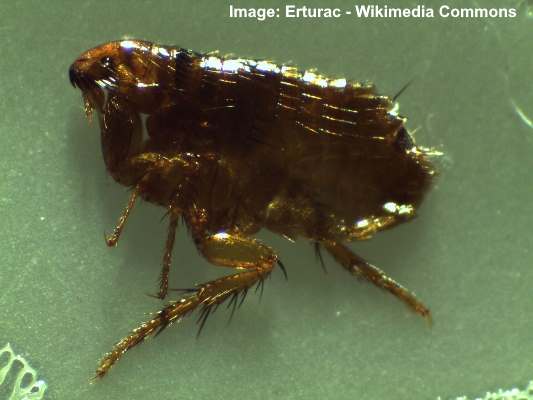
A close up picture of a flea
Fleas are tiny brown jumping bugs that spread disease and infections. Some fleas are microscopic bugs that can be as small as 0.04” (0.1 mm). However, some flea species can be as “large” as 0.13” (0.3 mm). The symptoms of flea bites—itchy red marks—are usually the only way to identify a problem with these brown biting bugs.
Deep cleaning fabrics or washing clothing with hot water can help get rid of fleas from a house. Usually, various pet products can help to rid animals of the tiny brown bugs.
Small Brown Bug Identification: Fleas look like tiny dots that may seem to disappear when they jump. An allergic reaction to a flea bite is sometimes the only way to identify fleas.
Ants (Formicidae)

Ants include numerous species that vary in size and color
Many types of ants are brownish insects with slender bodies and three distinct sections. There are over 22,000 species of ants, but most of them are tiny bugs that measure between 0.06” (1.5 mm) and 0.4” (10 mm) long.
Some reddish-brown ants, such as fire ants, can inflict a painful sting. Other types of light brown ants, like Pharaoh ants, only measure 0.03” (0.8 mm) long. Still, their vast numbers can become a problem as they nest in electrical outlets, wall voids, and cardboard boxes.
Other species of brown ants include:
- Crazy ants
- Odorous house ant
- Rover ant
- Argentine ants
Small Brown Bug Identification: Ants are easy to identify due to their six legs, two antennae, and distinct three-part body with a narrow waist.
Fruit Flies (Drosophila melanogaster)

Fruit flies are tiny brown house bugs that especially like sweet rotten fruit
Fruit flies are annoying small flying brown house bugs that hover around fermenting fruit and vegetables. The small brown flies have a light brown or tan body, measuring 0.1” to 0.15” (3 – 4 mm) in size. The best way to prevent fruit flies is to keep perishable foodstuffs in sealed containers or the refrigerator and keep the trash can closed.
Small Brown Bug Identification: Fruits flies are tiny brown flies that look like fungus gnats and are usually found near decaying food or garbage.
Termites (Isoptera)

Termites (Isoptera) are brown bugs that can infest homes and cause extensive damage to wood
Termites are destructive tiny brown bugs that measure between 0.25” and 0.5” (6 – 12 mm) long. Unfortunately, due to the habits of termites, you might never spot the long brown bugs until they have caused extensive structural damage in wood constructions. In addition, some brown termites have wings, and the swarming brown bugs can quickly set up new colonies.
Signs of termites include piles of frass (termite droppings), wood that sounds hollow, and mud tubes on exterior walls.
Small Brown Bug Identification: Termites look like ants, but they have a straight waist, straight antennae, and brown bulbous head. Brown winged termites have a pair of identical wings that are longer than their bodies.
Brown House Spiders
Many house spiders are brown bugs with long legs, and some have a nasty bite. Fortunately, most brown house spiders are harmless, so it’s vital to identify the particular species of spider to know if it’s dangerous or not.
The brown American house spider (Parasteatoda tepidariorum) is identified by its rounded tan-colored bulbous abdomen with brown patterns. The brown spiders are between 0.2” and 0.24” long.
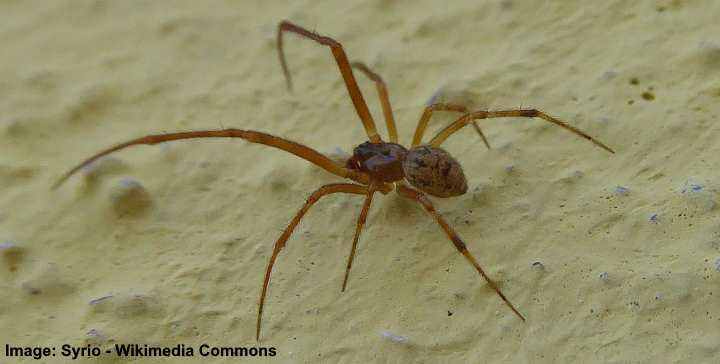
American house spider
The brown recluse (Loxosceles reclusa) is a venomous brown house spider with violin-shaped markings on the front part of its light brown body. The bite of these spiders can cause a severe allergic reaction.
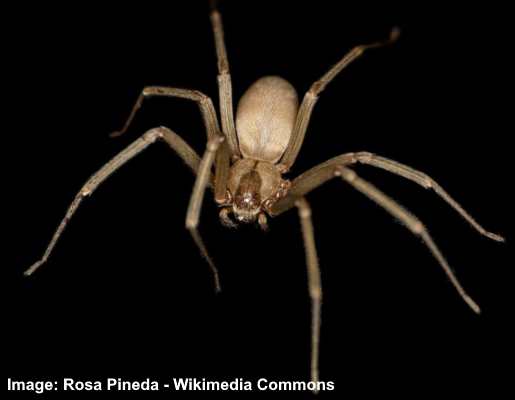
Brown recluse spider
The long-bodied cellar spider (Pholcus phalangioides) is a spindly brownish bug with long thin legs and a tear-shaped brown abdomen.
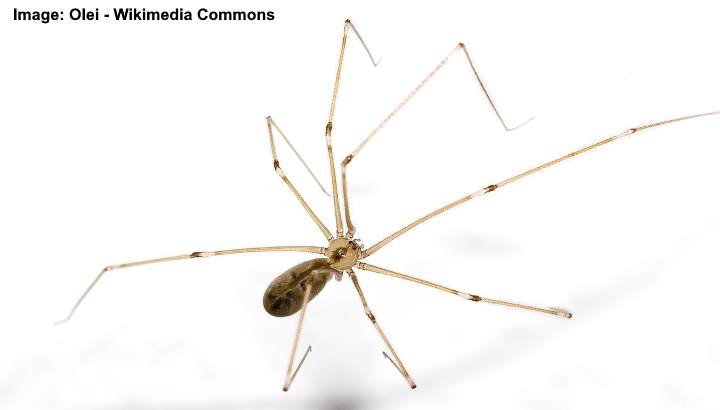
Long-bodied cellar spider (also known as daddy long-legs spider)
Small Brown Bugs with Hard Shell
Cockroaches (Blattidae)

Common roach (German roach/Blattella germanica) on the left and American roach (Periplaneta americana) on the right
Cockroaches are disease-carrying brown bugs with a hard shell and long antennae. Most species of cockroaches are identified by their flattened, oval body, long antennae, and fast movement. Unfortunately, cockroaches are difficult to spot because they prefer dark places. So, you may only see them when turning on a light or opening a cupboard door.
The American cockroach (Periplaneta americana) has an identifiable reddish-brown flattened body that measures 1.6” (4 cm) long, six spiny legs, and two antennae. The winged flying brown bug can also fly short distances.
The common cockroach (Blattella germanica) is reddish-brown with slender oval bodies that measure 0.6” (15 mm) long.
The brown cockroach (Periplaneta brunnea) looks similar to the American cockroach, but is smaller and a darker shade of brown.
The brown-banded cockroach (Supella longipalpa) is identified as a light brown cockroach with recognizable dark brown bands across its wings.
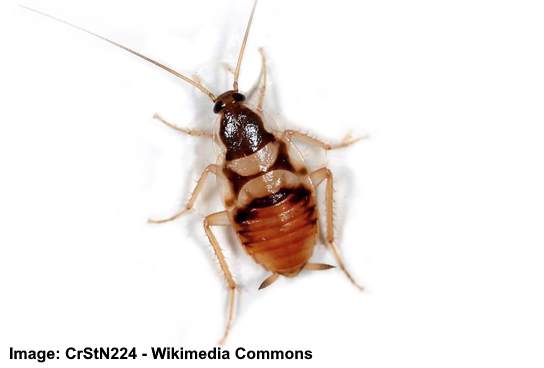
Brown-banded cockroach
Pillbugs (Armadillidiidae)
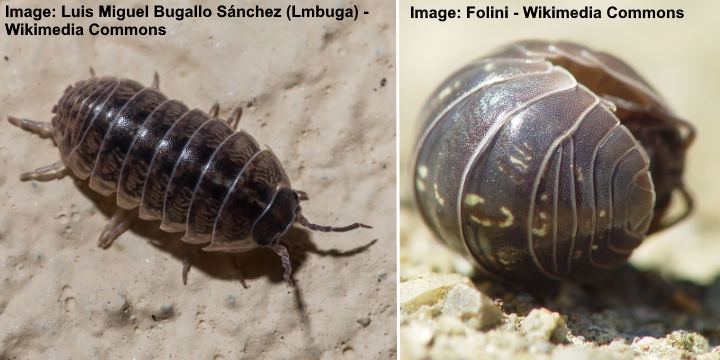
Pillbugs have dark brown hard segmented shell and can roll when they feel threatened
Pillbugs are small brownish-black hard-shelled bugs that can roll into a ball for defense. The adult bugs have a distinctive segmented gray or brown hard shell that looks like a tiny armadillo. The tiny dark brown bug has seven pairs of legs. Pillbugs measure between 0.25” and 0.5” (6 – 12 mm) long.
Pillbugs also have the common names roly-polies, slaters, potato bugs, and doodlebugs.
Small Brown Bug Identification: To identify pill bugs, look for their dark brown segmented hard shell divided into plates.
Earwigs or Pincher Bugs (Dermaptera)
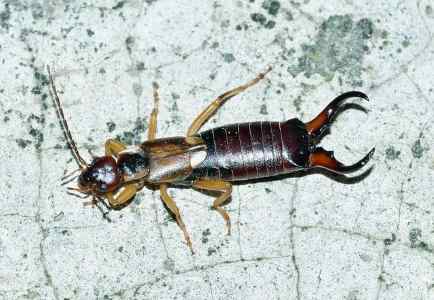
Earwigs (pincher bugs) are small skinny brown-black bugs that have pincers and antennae
Earwigs, also known as pincher bugs, are small skinny brown-black bugs that have pincers and antennae. Earwigs are are easy to identify due to the pincers on the hind section of most species. During warm weather, earwigs are found outdoors feeding on plants. Earwigs come into homes, garages, and other buildings to find shelter during cold weather.
Earwigs are insects in the order Dermaptera and there are about 12,000 species of these small brown nocturnal insects.
Their scientific name Dermaptera literally means “skin wings” and this describes their wings that are rarely used and seem to form part of their body.
Small Brown Bug Identification: To identify earwigs look for long skinny brown bug with pincers and antennae.
Discover the most common brown bugs on plants and learn how to identify them.
Related articles:
